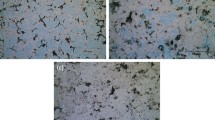Abstract
Impurities are a major source of uncertainty in the temperature of a thermometry metal fixed point (of the order of 1 mK). A better understanding of the impurity effect is required to improve top-level metrological thermometry. This investigation reports on some unusual effects of antimony doped into a high-purity (99.9999%) tin sample. The change in temperature and shape of the melting and freezing curves of the tin, caused by low concentrations of the Sb dopant, were measured in order to test the interpolation of previous data. Most historical experiments have worked at much higher impurity concentrations—say of the order of 100 ppm—and in arrangements that are not used on a day-to-day basis in a metrology laboratory. These measurements on the tin were done after doping at mass fractions of approximately (1 and 25) parts per million by weight (ppmw) of antimony. Repeated melting and freezing curves, before and after doping, confirmed the reproducibility of the temperature measurements in this tin cell. The freezing temperature of the tin after adding antimony was higher than for “pure” tin. However, the temperature change was less than expected, being an average (+0.06±0.03) mK · ppmw−1. Samples from the tin were analyzed by glow discharge mass spectrometry (GD-MS) before and after doping to detect the distribution of all the impurity elements. If the dopant level detected by GD-MS was used, then a value of (0.18 or 0.29) mK · ppmw−1 was calculated (much closer to the value interpolated from earlier works). There was evidence that the thermal history of metal phase transitions can cause considerable segregation of some impurities and that the effects of this segregation can be clearly seen on the shape of the melting curves of tin doped with Sb. (The segregation might be more pronounced as Sb forms a peritectic in tin, i.e., a “positive” impurity which increase the phase transition temperature).
Similar content being viewed by others
References
Preston-Thomas H.: Metrologia 27, 3 (1990)
D.R. White, M. Ballico, V. Chimenti, S. Duris, E. Filipe, A. Ivanova, A. Kartal Dogan, E. Mendez-Lango, C. Meyer, F. Pavese, A. Peruzzi, E. Renaot, S. Rudtsch, K. Yamazawa, Uncertainties in the Realisation of the SPRT Subranges of the ITS-90, CCT-WG3 (CCT/08-19/rev) (BIPM, France, 2009), http://www.bipm.org/cc/CCT/Allowed/24/D19/_rev/_WG3/_Doc/_rev/_10July2009.pdf
Hansen M.: Constitution of Binary Alloys. 2nd edn. McGraw-Hill, New York (1958)
Ancsin J.: Metrologia 44, 303 (2007)
Zhang J.T., Rudtsch S., Fahr M.: Int. J. Thermophys. 29, 151 (2008)
Qiu P., Sun J., Zhang J., Zhijun J.: Acta Metrol. Sin. 29, 79 (2008)
P. Petchpong, D.I. Head, The influence of titanium on the aluminum fixed-point temperature. Int. J. Thermophys. (submitted)
Author information
Authors and Affiliations
Corresponding author
Rights and permissions
About this article
Cite this article
Petchpong, P., Head, D.I. The Effect of Low Level Antimony on the Tin Temperature Fixed Point. Int J Thermophys 32, 1525–1534 (2011). https://doi.org/10.1007/s10765-011-1000-4
Received:
Accepted:
Published:
Issue Date:
DOI: https://doi.org/10.1007/s10765-011-1000-4




